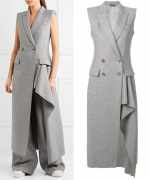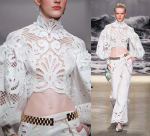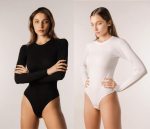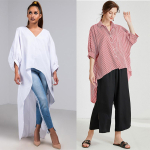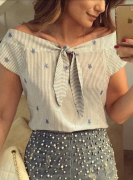Size charts What is the height of the pattern Payment methods Ask a question Reviews
Electronic pattern for printing in full size on a home printer or plotter. Can be printed on sheets of paper from A4 to A0. Paperless cutting through the projector is possible.
Free download Instructions on how to sew a vest-jacket pattern for this pattern
How to sew a vest - a jacket with your own hands according to a finished pattern at home
Contents of the instruction:
- Description of patterns.
- A set of patterns for sewing a vest and a style design.
- From what to sew a simple vest - a jacket, what kind of fabric consumption.
- How to cut a women's vest - a jacket according to a finished pattern.
- How to sew a vest - jacket at home - sequence.
 Buy and download this jacket vest pattern
Buy and download this jacket vest pattern
1. Description of patterns
Sizes: 40-52 or 52-64, all sizes are printed from one file.
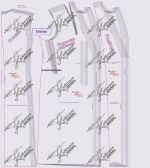 File format: PDF full size and without seam allowances
File format: PDF full size and without seam allowances
After paying for the order, you will receive links to download two files patterns of a vest - a jacket of a gradation of sizes from 40 to 52 or from 52 to 64:
- PDF file A4, adapted for printing patterns on sheets of A4 paper in any program on any device, including mobile phones.
- Multi-format PDF file for printing on sheets of any size from A0 to A4 on a printer or plotter using Adobe Reader.
Pattern assembly diagram when printing on A4 sheets of a home printer
The pattern is assembled from 60 A4 sheets on two large pages of patterns.
Both pages of patterns are 30 sheets each: 5 rows of 6 sheets in a row.
For a file with sizes from 52 to 64:
The pattern is assembled from 65 sheets of A4 paper on two large pages of patterns.
1 page of patterns: 5 rows of 7 sheets in a row.
2 page of patterns: 5 rows of 6 sheets in a row.
The level of complexity of sewing is professional, assuming the ability to process an English collar and a pocket with a flap. This pattern is not for beginner couturiers.
 The style of this vest - jacket is suitable for figures of various fullness.
The style of this vest - jacket is suitable for figures of various fullness.
The pattern is designed for sewing at home on household sewing machines. For high-quality sewing, you will need at least a mannequin.
2. A set of patterns for sewing a vest and a style design
2.1. Complete set of patterns of a vest - a jacket
- The shelf is left and the side of the left shelf.
- The shelf is right.
- Back.
- Pick-up - with marking the length of the left and right sides.
- Collar patterns.
- Pocket flap patterns.
Patterns for frame details and pocket burlap are not included. Their cutting is described below.
2.2. Description of the design of the pattern of the vest - jacket
 This model is designed "based on" the Alexander McQueen vest-jacket from the 2017 winter collection.
This model is designed "based on" the Alexander McQueen vest-jacket from the 2017 winter collection.
The vest-jacket is made on the basis of a similar to a classic men's double-breasted jacket. A small chest tuck is added to the base.
The silhouette is semi-adjacent, there is only one tuck in the design (semi-relief from the armhole to the pocket).
Please note that using this set of patterns, you can sew vests of two styles.
The first is close to the one created by Alexander, the second is a classic double-breasted with the same shelves.
3. What to sew a simple vest - jacket, what fabric consumption
3.1. What to sew and how to calculate fabric consumption
The choice of fabric depends on the season. A summer vest can be sewn from thin suit fabrics. Ideal for costume linen and  suit silk.
suit silk.
Of course, preference should be given to natural fabrics with a small addition of synthetic fibers. It is these fabrics that retain the properties of their natural components, but do not give deformation and shrinkage in the sock.
For the cold seasons, any dress and costume wool is suitable.
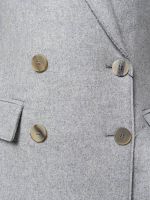 With a certain processing, double-sided fabrics can also be used.
With a certain processing, double-sided fabrics can also be used.
Consumption for a long vest - jacket with a fabric width of 140 - 150 cm will be from 230 to 280 cm.
Pay attention to the fact that before a set of fabric, it is advisable to choose a method for processing the sides and perform a preliminary layout of the patterns.
If you have insufficient experience in sewing jackets and jackets, then it is better to choose loose fabrics that can hide sewing flaws. "Hard" and "dry" "suits" are recommended only for experienced couturiers.
3.2. Instructions on how to buy, how to print and others
How to choose a size without using tables and taking measurements
What height are the patterns for?
How to buy a ready-made electronic pattern
How to print a pattern at home in full size on A4 sheets or on sheets of any other size
How to assemble a pattern after printing
Simple patterns of dresses, sweatshirts, skirts and trousers in full size free download
 Buy and download this jacket vest pattern
Buy and download this jacket vest pattern
4. How to cut a women's vest - a jacket according to a finished pattern
Before cutting, you need to clearly understand exactly how you are going to process the sides of the vest. Consider the most obvious options.
- "Classic" turning sides - cut out exactly according to the pattern. See the description for an example of similar coat patterns - a jacket of small sizes. Such boards for this model are only suitable for very thin fabrics.
- Combined sides - one-piece bottom (up to the waist) and turned upper part (with a lapel). An example of such a combined selection in the description patterns of a coat - a jacket of the big sizes and in the description coat patterns - jacket "new classic" This option can be used for relatively loose and "heavy" fabrics.
- The pick-up can be made short, to the waist. But this, of course, with appropriate processing of the edge of the side down from the waist and the very bottom.
- If the fabric is double-sided, then in some cases, you can do without the picks.
After the option for processing the sides is thought out, you can start cutting.
Cutting asymmetric products is performed on a fabric spread in one layer. One of the cutting options is shown in 2 drawing.
To avoid turning parts, you can cut on the right side of the fabric.
The share thread, as for classic jackets, is perpendicular to the horizontal of the waist, that is, along the half-skid for the front and along the center line for the back.
For headboards, the share is parallel to the bottom of the edge of the bead.
The share thread for the lower collar is along the rake line, for the upper one - along the middle line.
Seam allowances are given as for the processing proposed by the author of the model McQueen.
Seam allowances 1 cm along the "vertical" and shoulder sections. Please note that for the semi-relief it is also 1 cm, but there is no allowance for seams along the cut of the pocket for the left shelf and for the barrel of the left shelf.
In addition to these allowances, we add 1 cm along the cut of the collar for the lower collar, and 1,3 - 1,5 cm for the upper collar (excess can be cut off in the process of flying the collar).
At the bottom, you can not add. Allowances are also not added along the cuts of the sprout, the neck, the edge of the lapel and the departure edge of the collar.
Duplicate only the lapel area on the shelves and the lower collar. If the valve is double, then the subvalve can be duplicated. Dubbing is cut out strictly according to patterns without seam allowances.
After cutting, notches are made at the waist, for which all parts are folded together.
Then, markings of the half-skid and the inflection of the lapel are applied to the shelf. This marking should be preserved until the product is ready, so we apply it with a thread.
Undercut facings for pockets can be done just before they are made, that is, after processing the shelves.
Pockets can be of two types: a frame with a valve or leaflet with a valve.
For leaflets, the width of the facings in the cutting is 4 cm (2 parts are needed), for frames - 2 - 2,5 cm (4 parts are needed).
The length of the facings in the cut = the length of the entrance to the pocket + 4 cm.
Burlap is a rectangle. The width of the burlap \u30d the width of the facings in the cut, and the length in the cut is 34 - XNUMX cm.
5. How to sew a vest - jacket at home - sequence
Consider processing similar to the one proposed by the author of the model Alexander McQueen.
No matter how simplified the processing of the jacket vest is, wet-heat treatment followed by drying on a mannequin should not be neglected.
Approximate sewing sequence.
- Processing of tucks and semi-relief. To the cut of the pocket of the left shelf end-to-end, the barrel is joined with temporary stitches before the pocket is processed. This can be done manually or by machine.
- WTO shelves, including duplication of lapels.
- Preparing to make pockets: iron along the facing, make flaps, make precise symmetrical marking of pockets on the shelves.
- Make pockets and iron them.
- Process the boards in the way you choose.
- Process the back - the middle seam and the WTO.
- Sweep (machine or hand) and press (lightly) the shoulder and side seams to try on.
- Prepare shoulder pads.
- Process the lower collar - the middle seam, WTO and dry.
- 10. Run a fitting. In addition to the fit and volume of the product, you should try on the lower collar and, if necessary, correct the cut of the departure. It is also desirable to trim the armholes to fit. How to cut an armhole
- Finish shoulder and side seams.
- Process the collar and sweep it.
- Second sample. We check the fit of the collar on the figure and mark the loops. The best option is to mark the upper loop 2 - 3 cm above the waist.
- Stitch the collar.
- Process the armholes (lay around a couple of lines).
- Process the bottom.
- Loops, finishing ironing, drying, buttons.
Download this pattern pdf:
Pattern vest - jacket
$2.50 (100 hryvnia)
Bank cards of the Russian Federation are not accepted for payment!
Size charts What is the height of the pattern Payment methods Ask a question Reviews
Vera Olkhovskaya in social networks:

See similar clothing patterns and how to sew on them
-
Any pattern for free for a review of a previously made order
More...
Lifetime promotion for buyers of patterns!

Leave a review about my store of patterns for an order that you made before, and you will receive any paid pattern of your choice Free!
